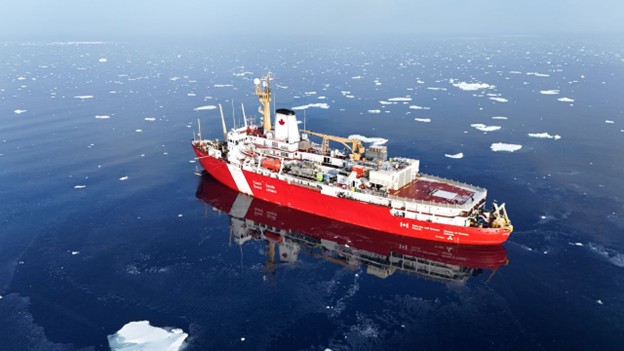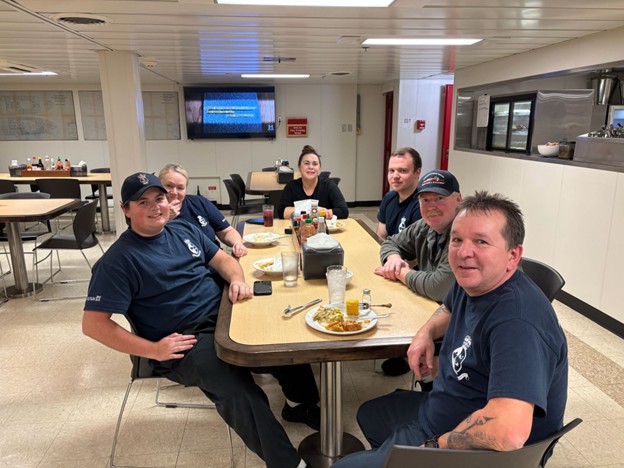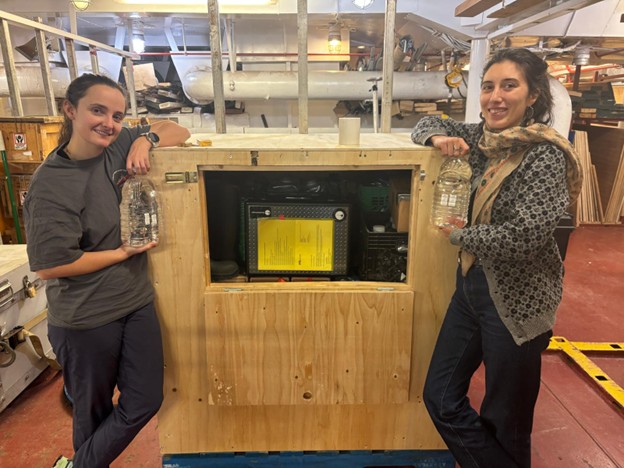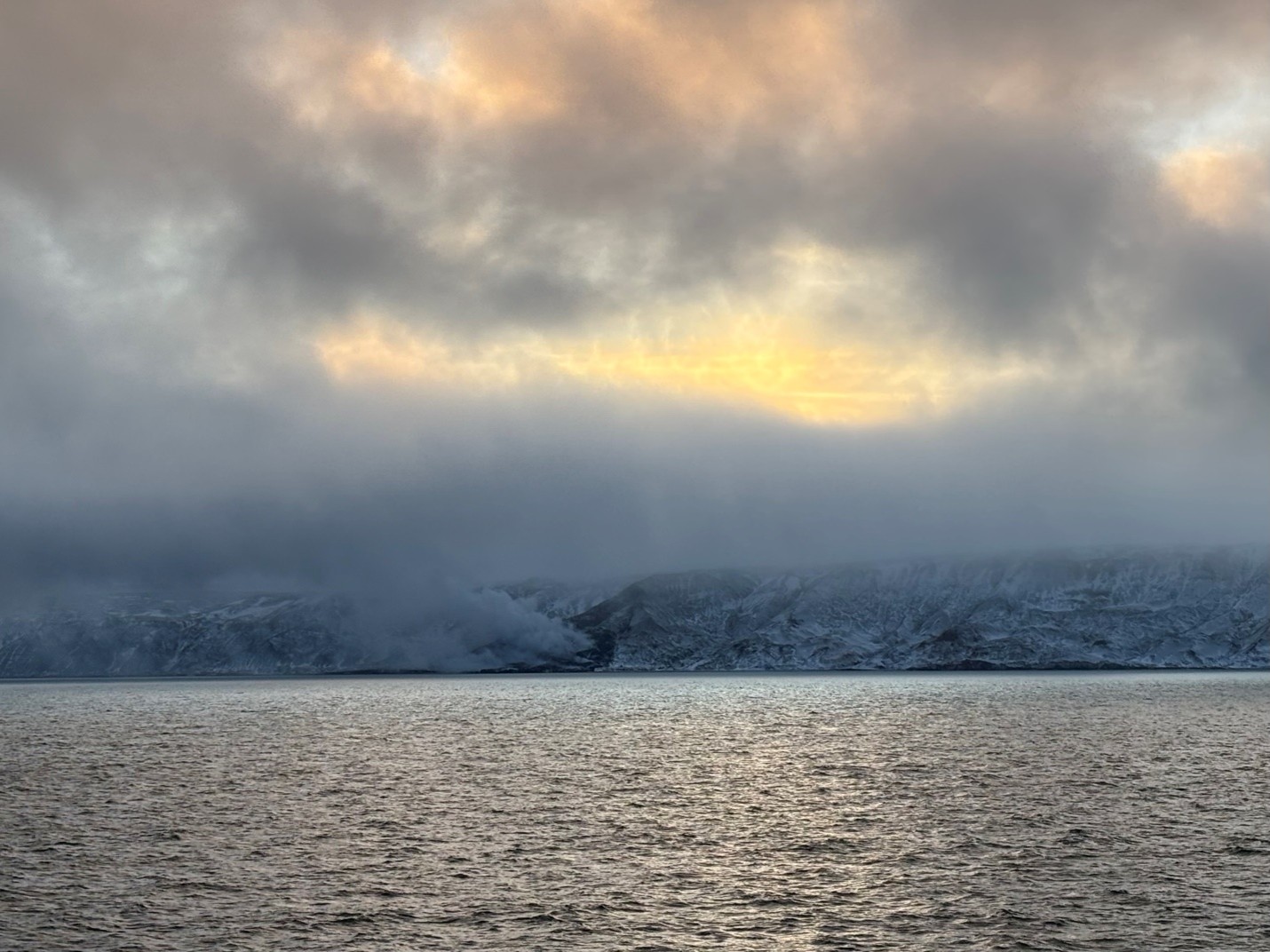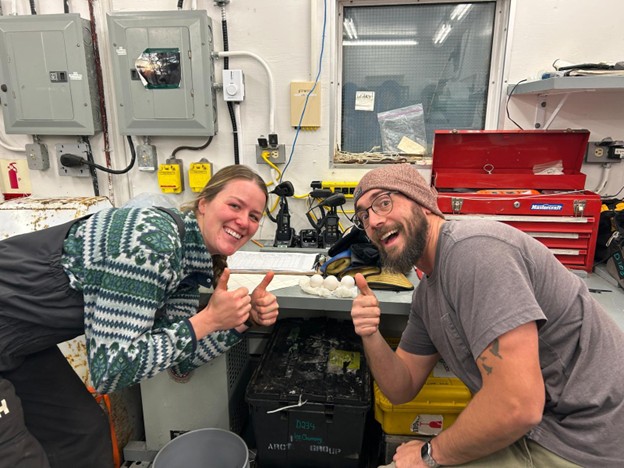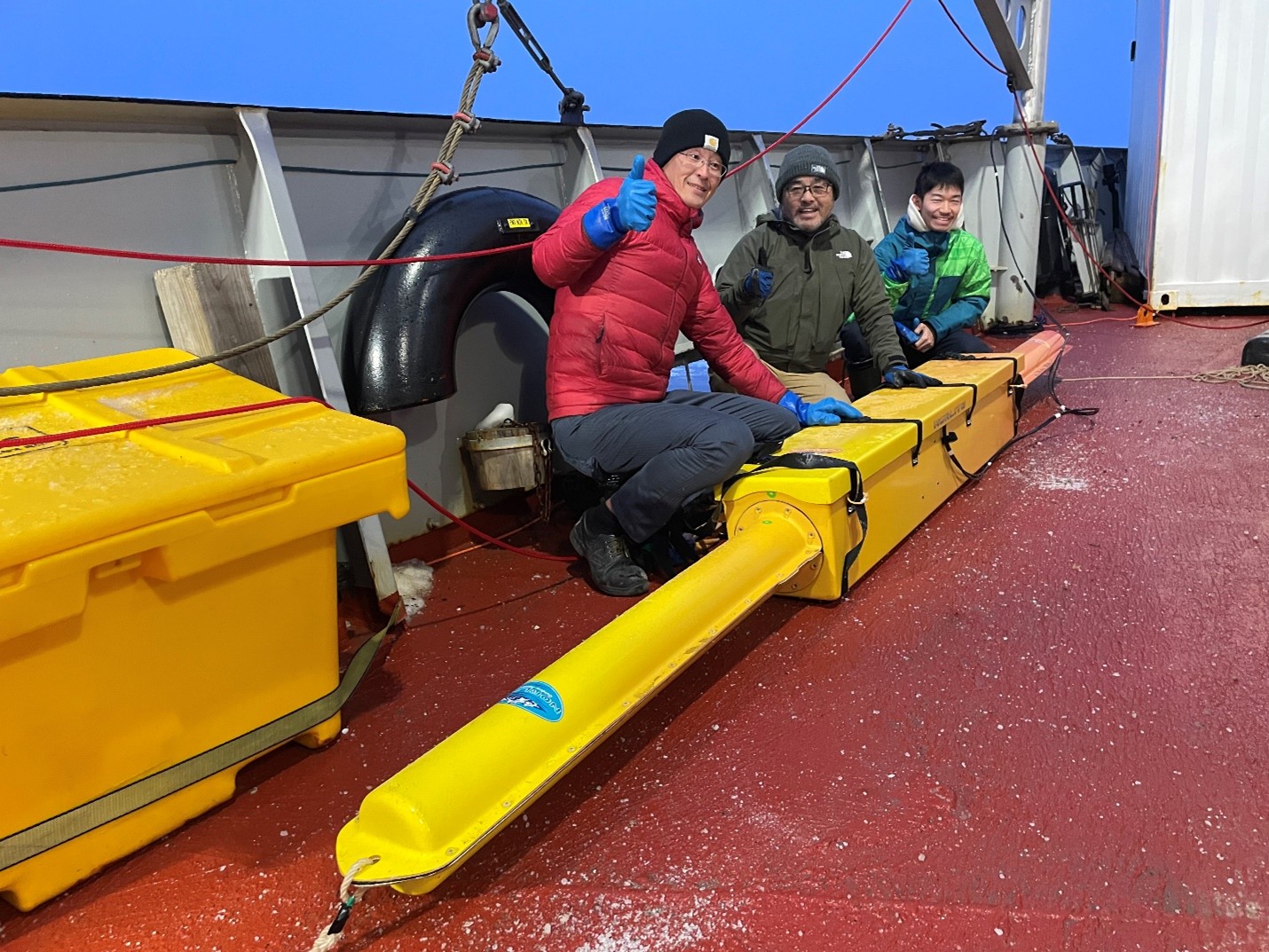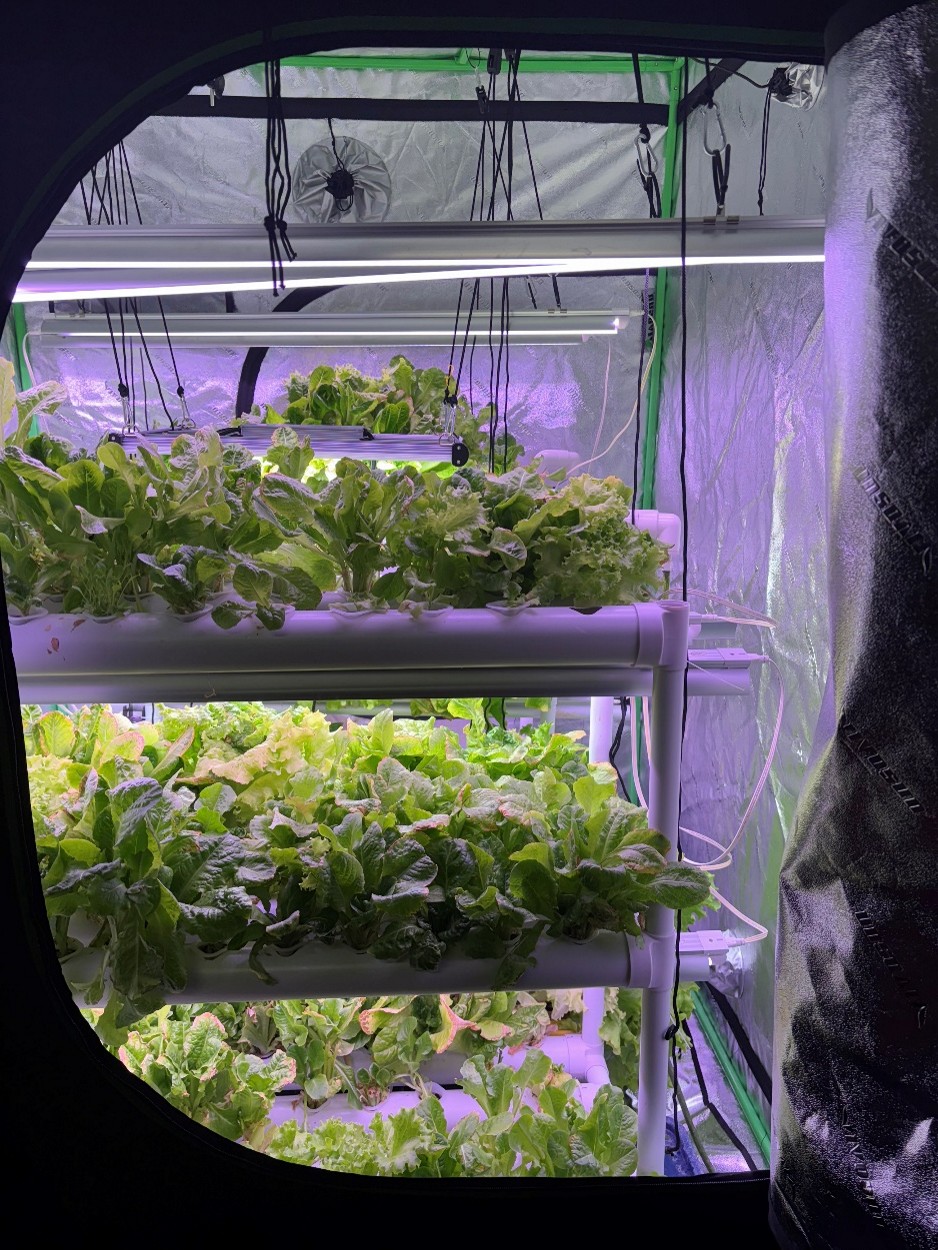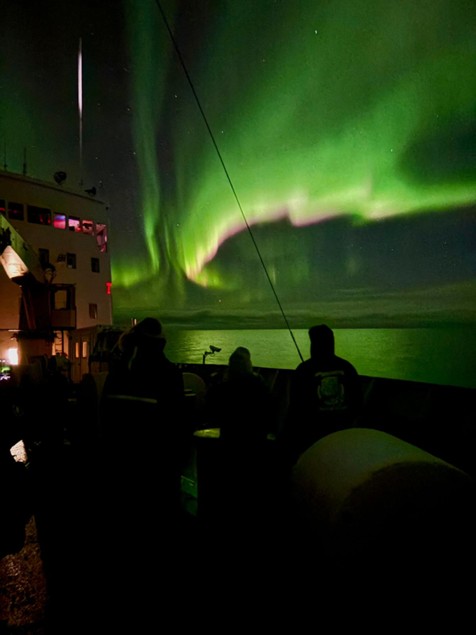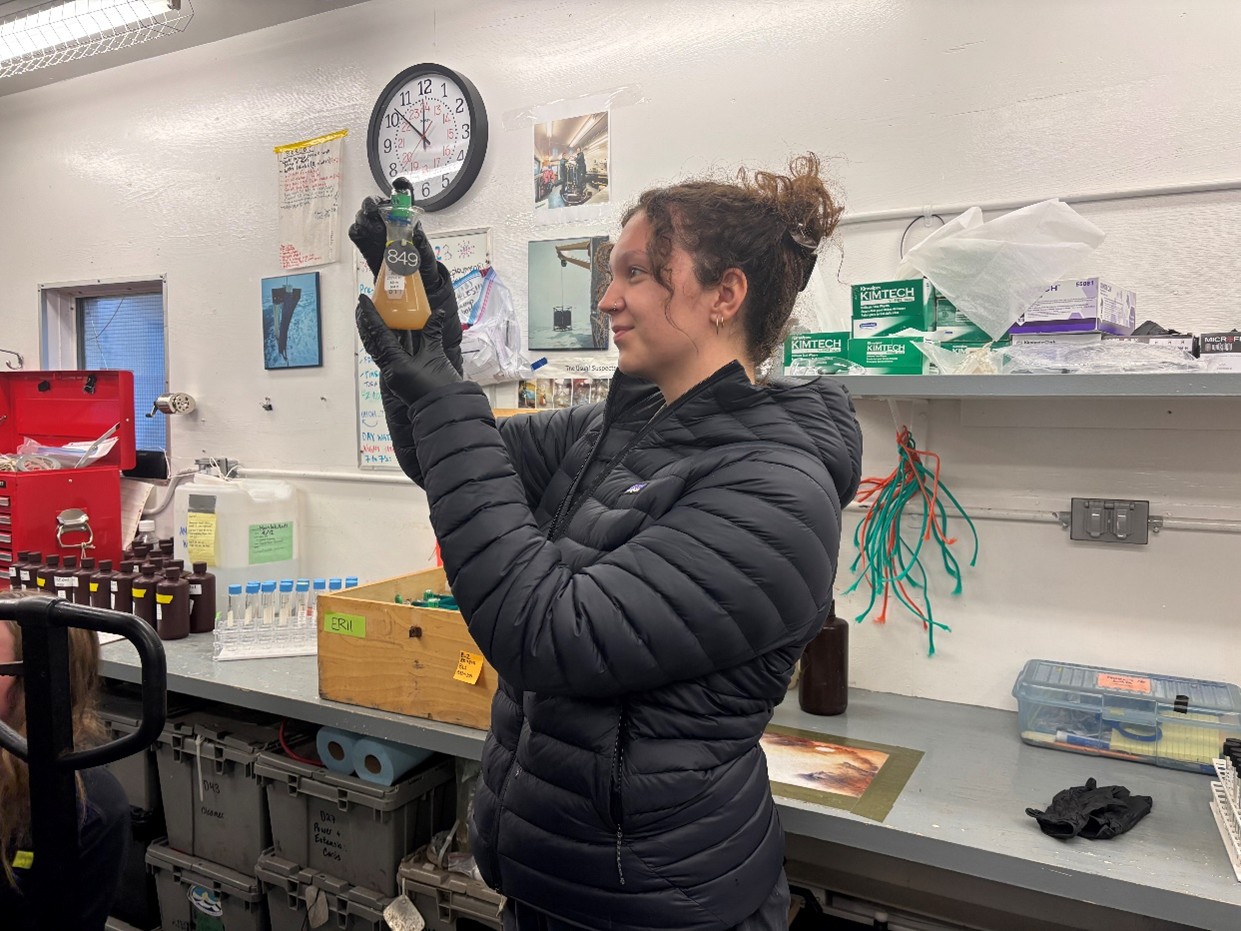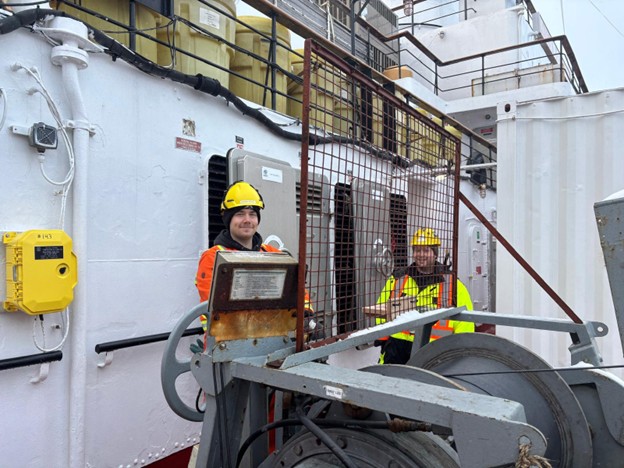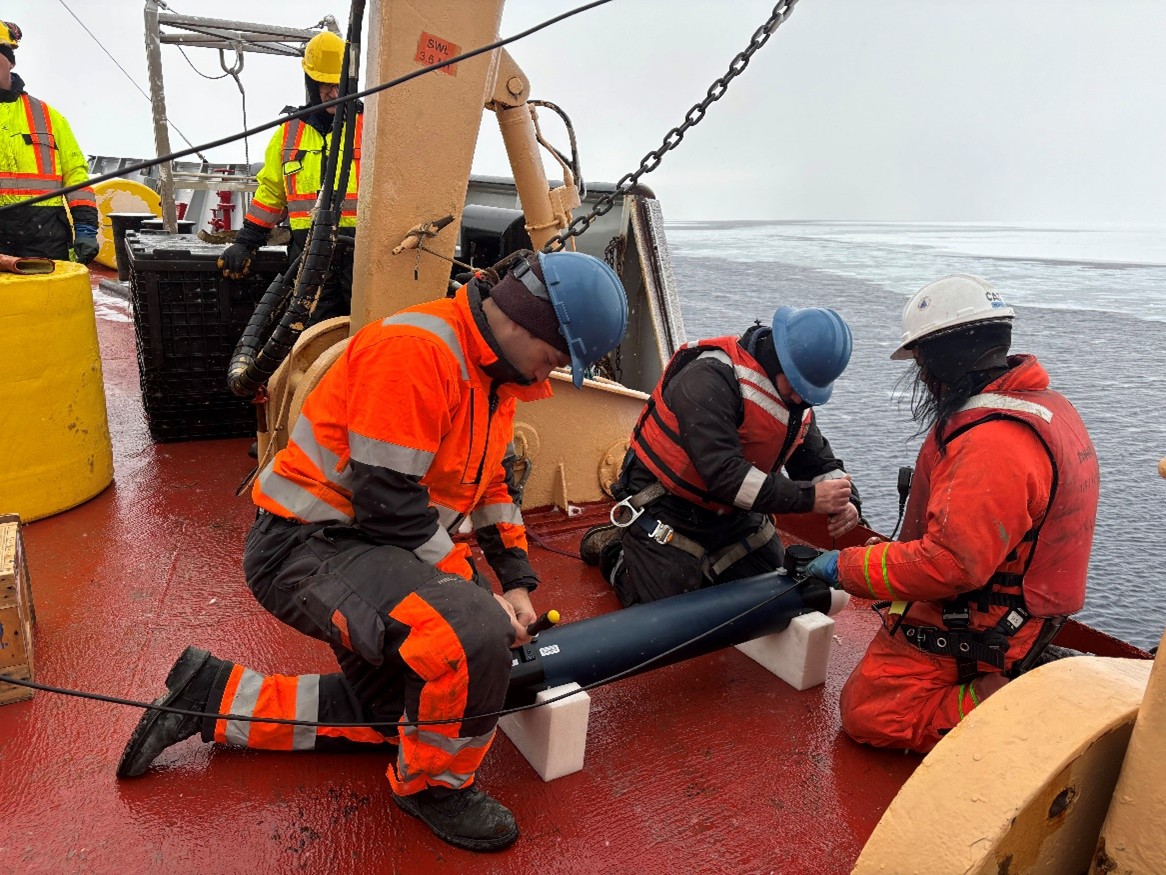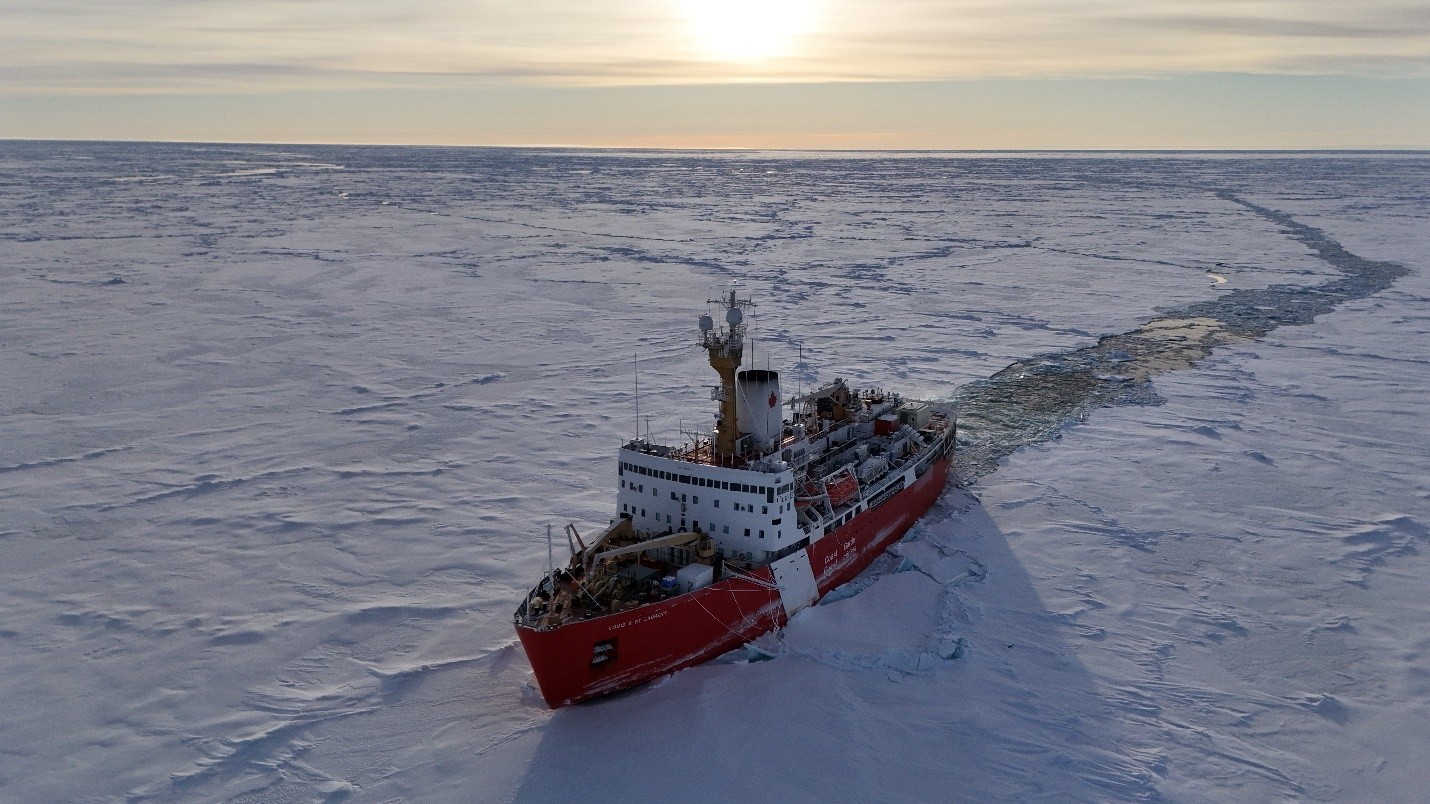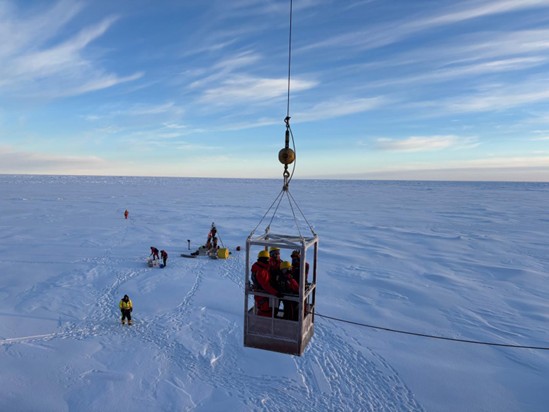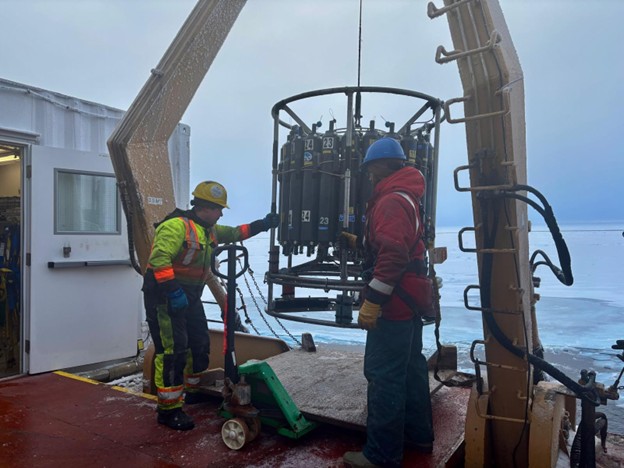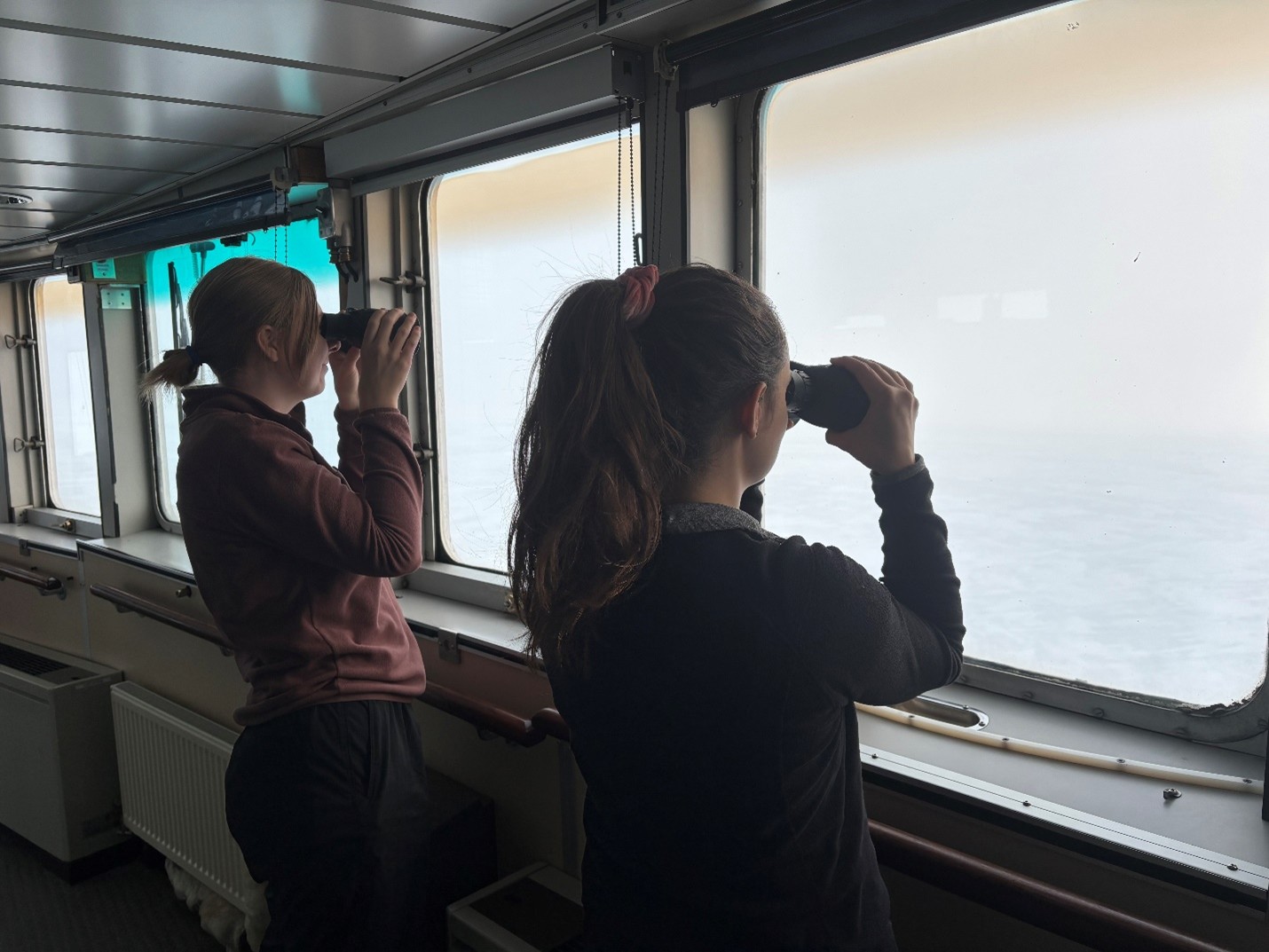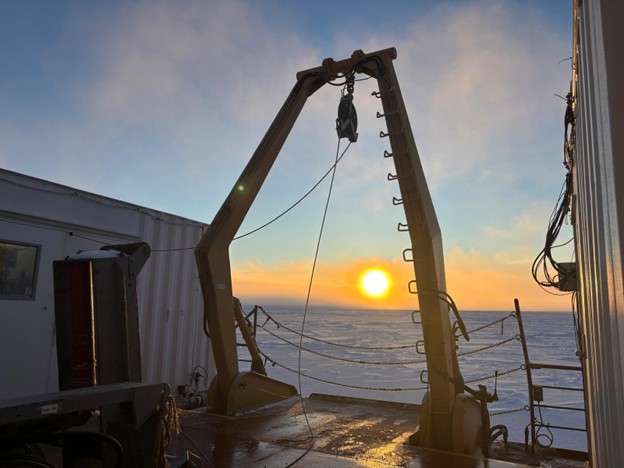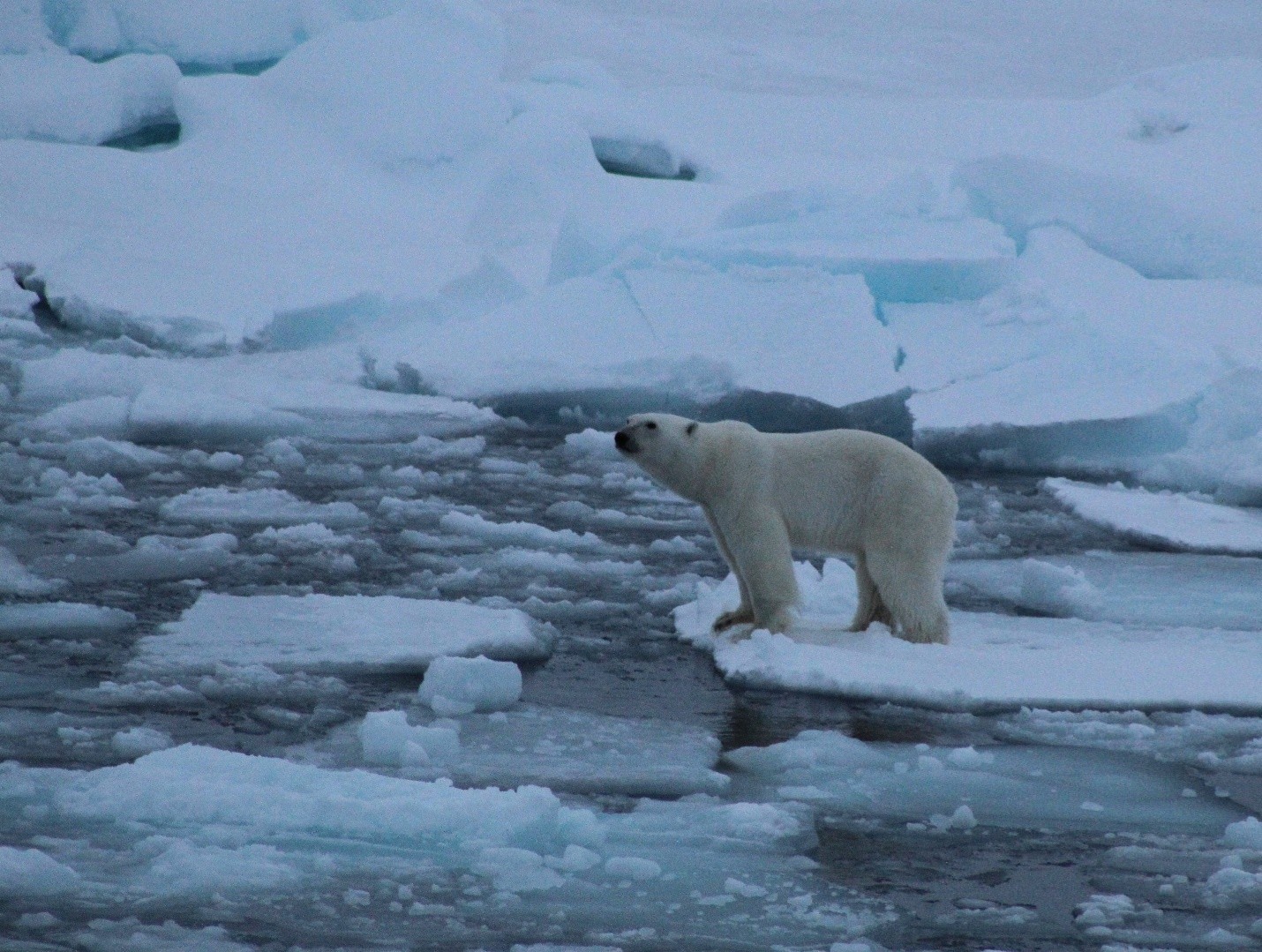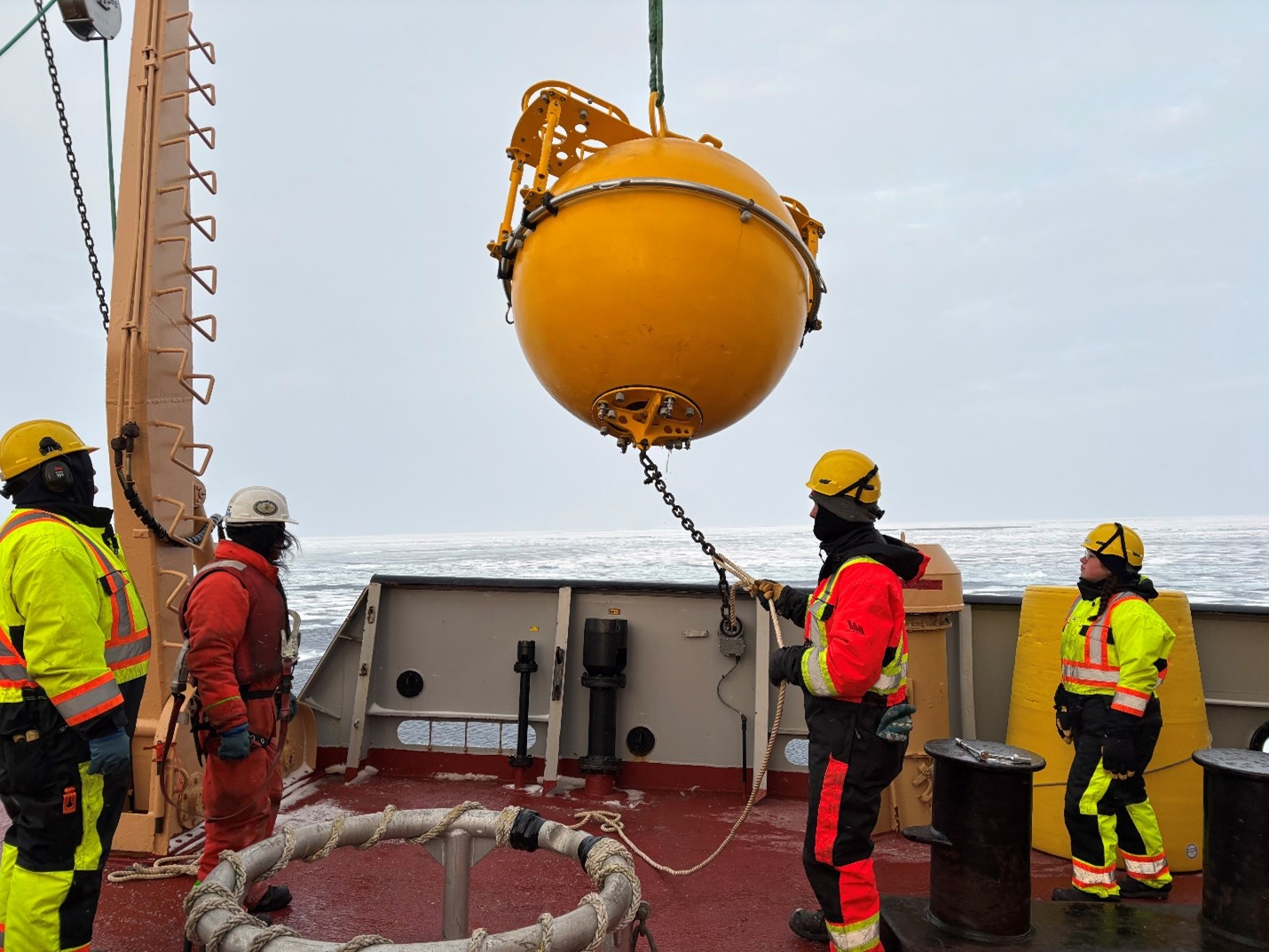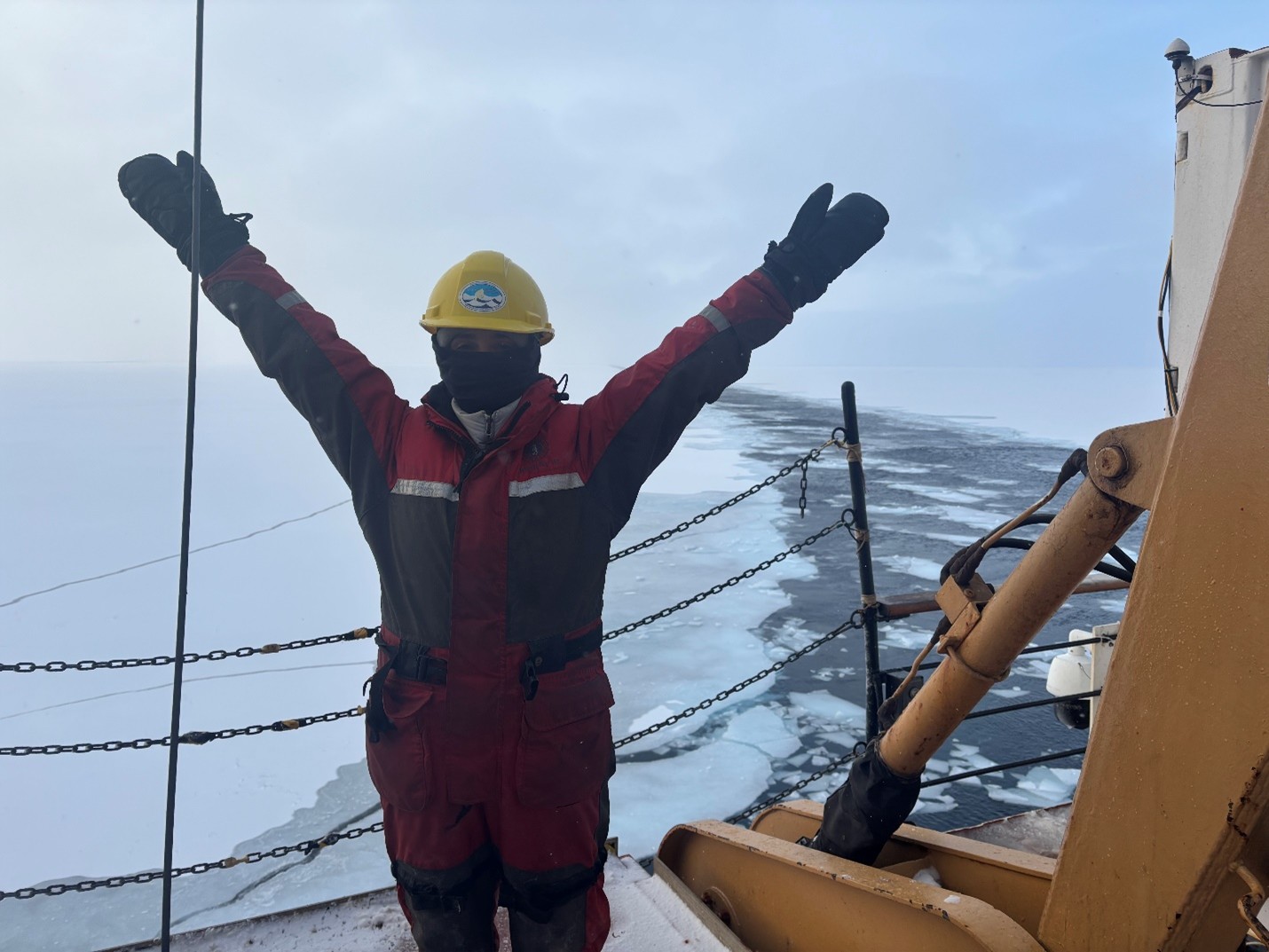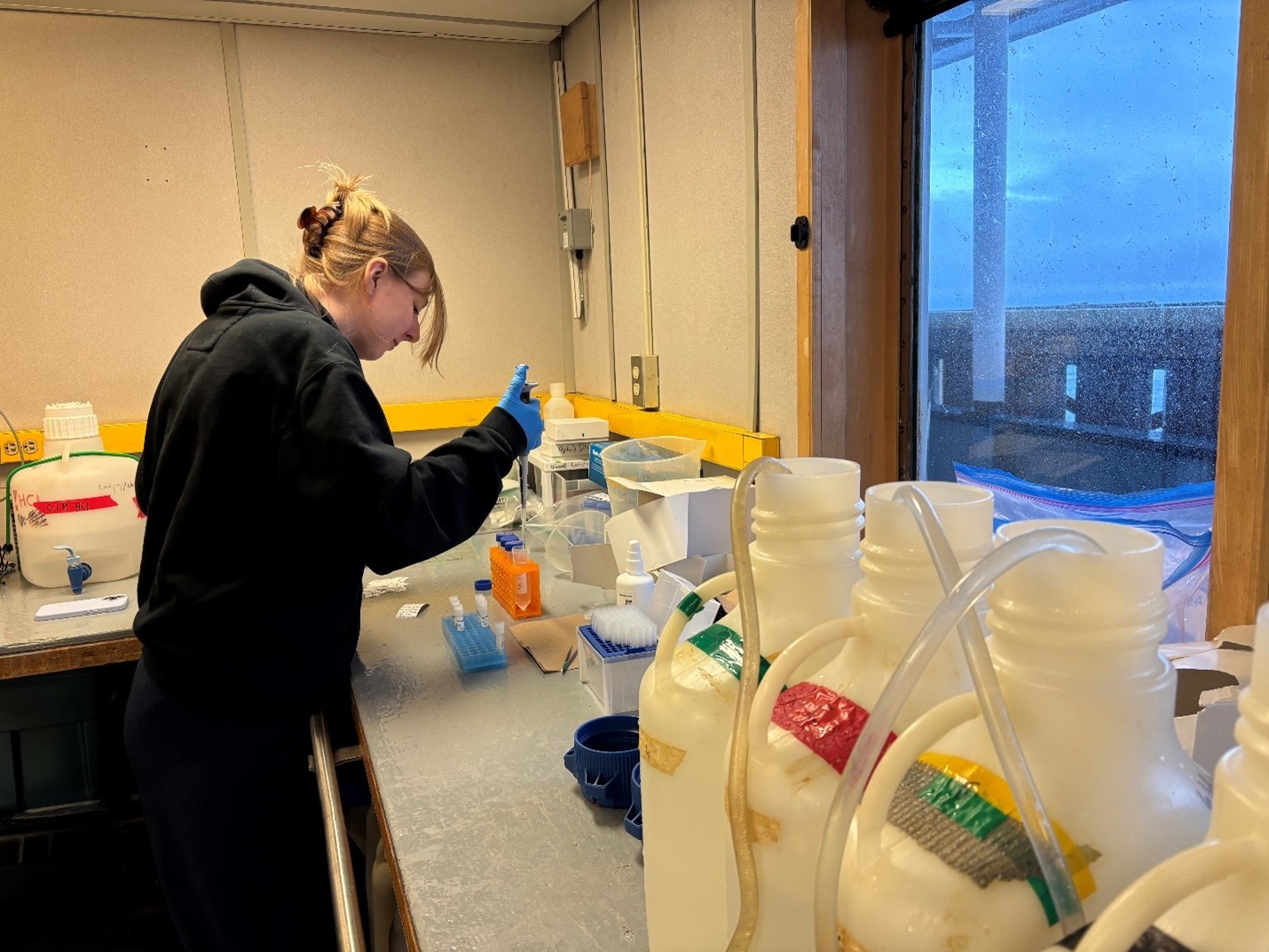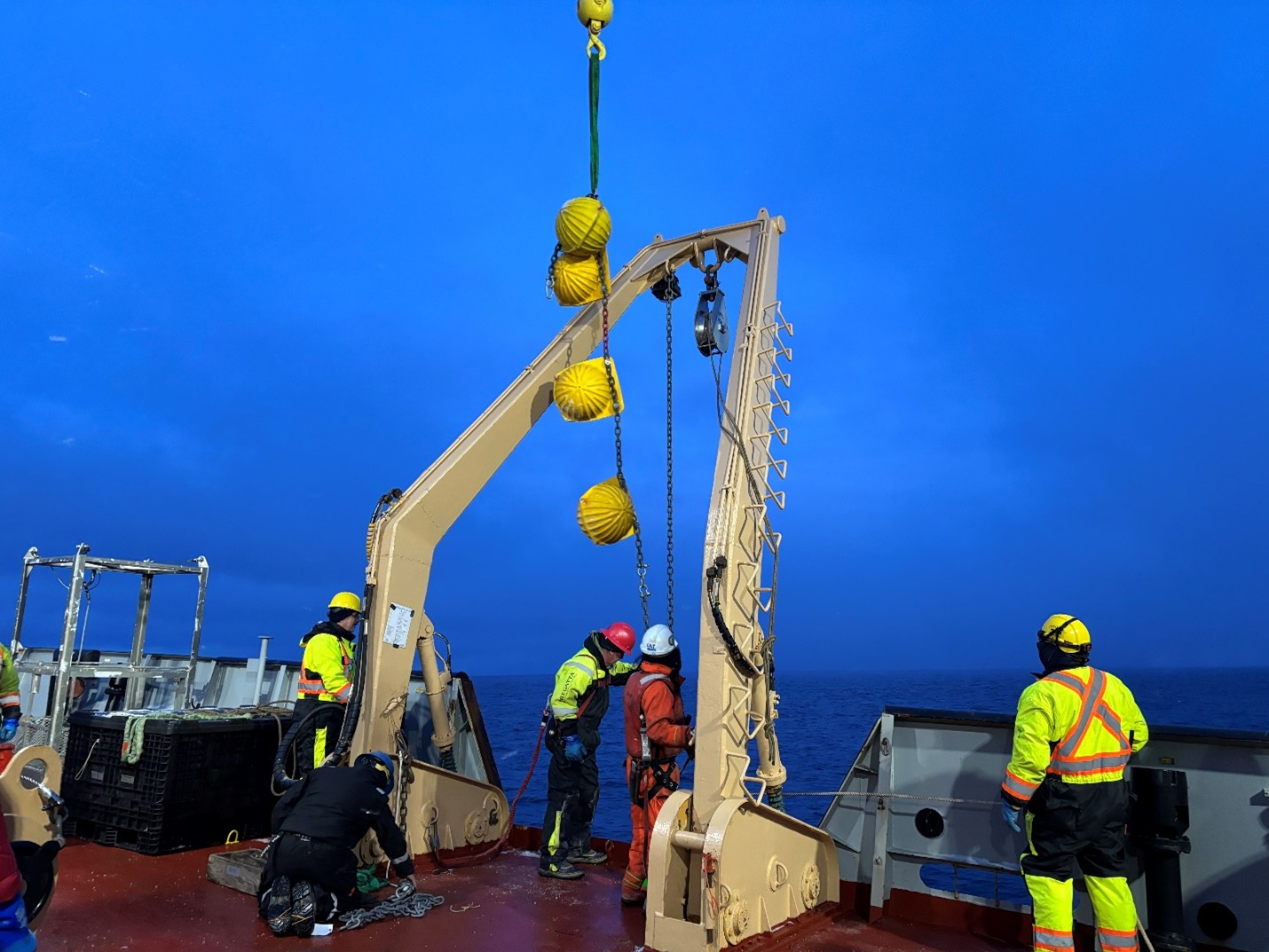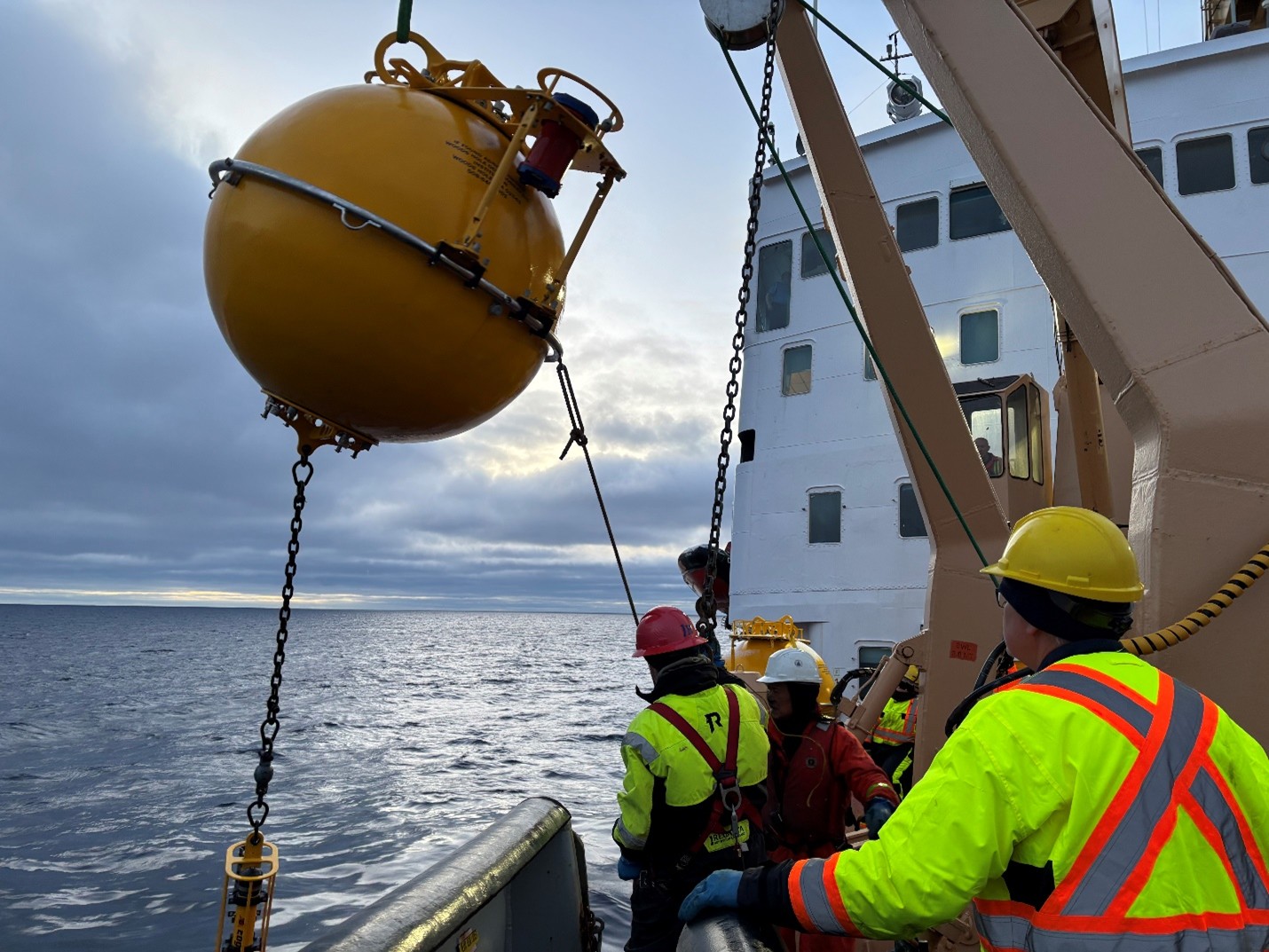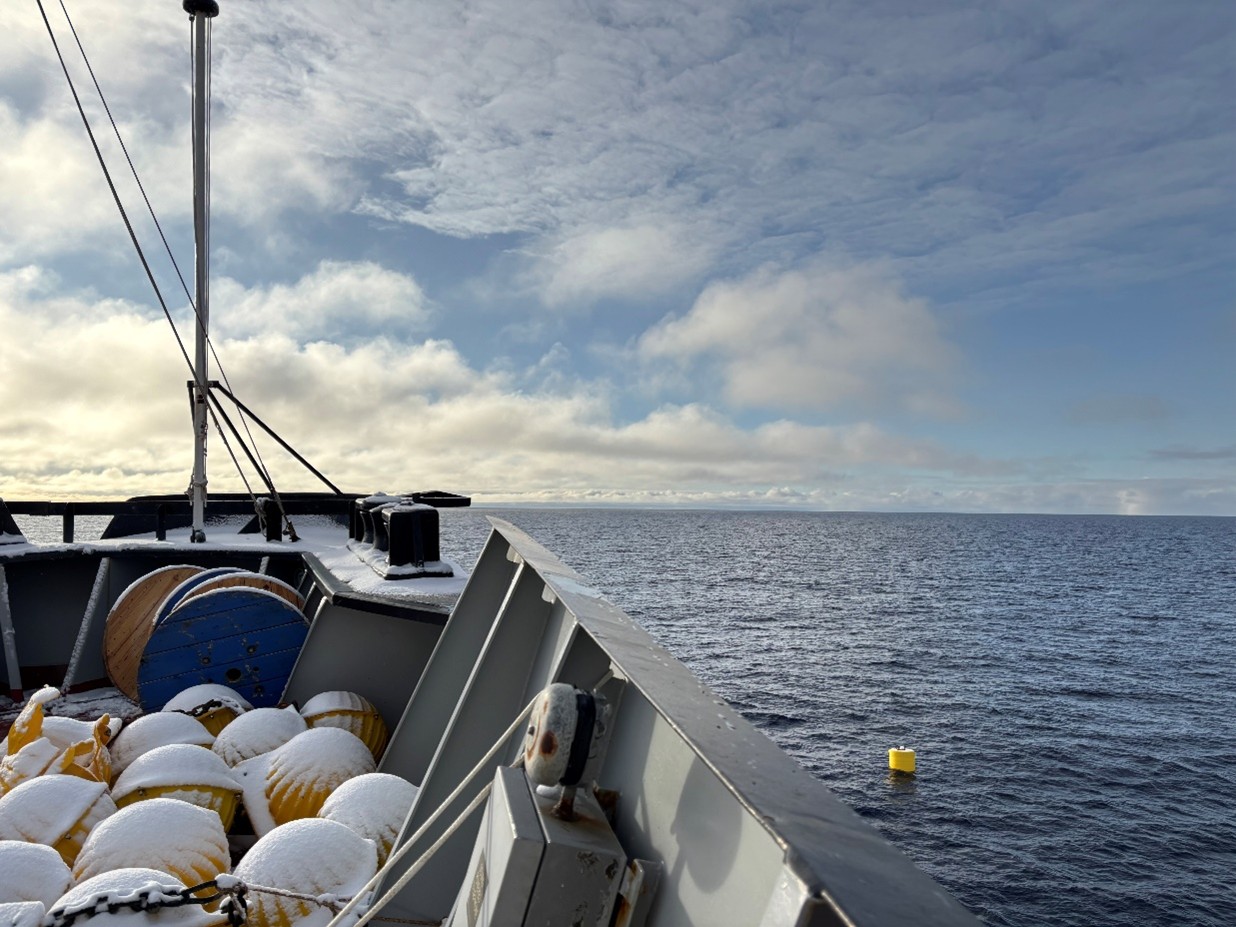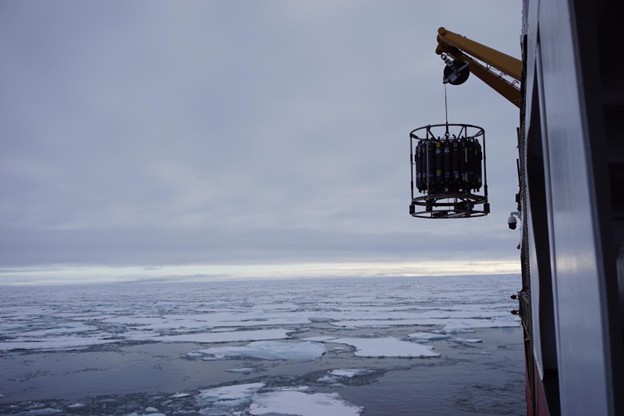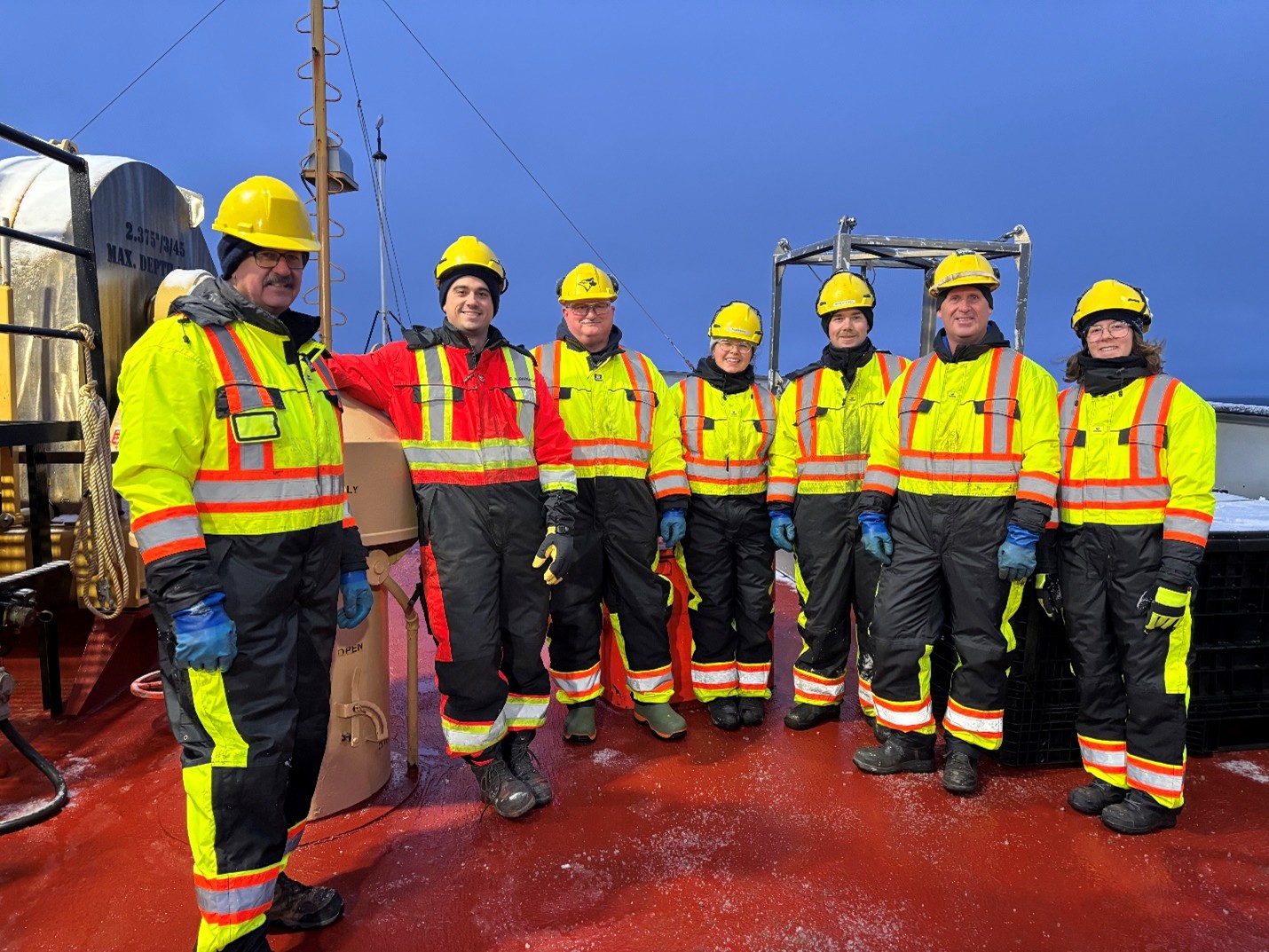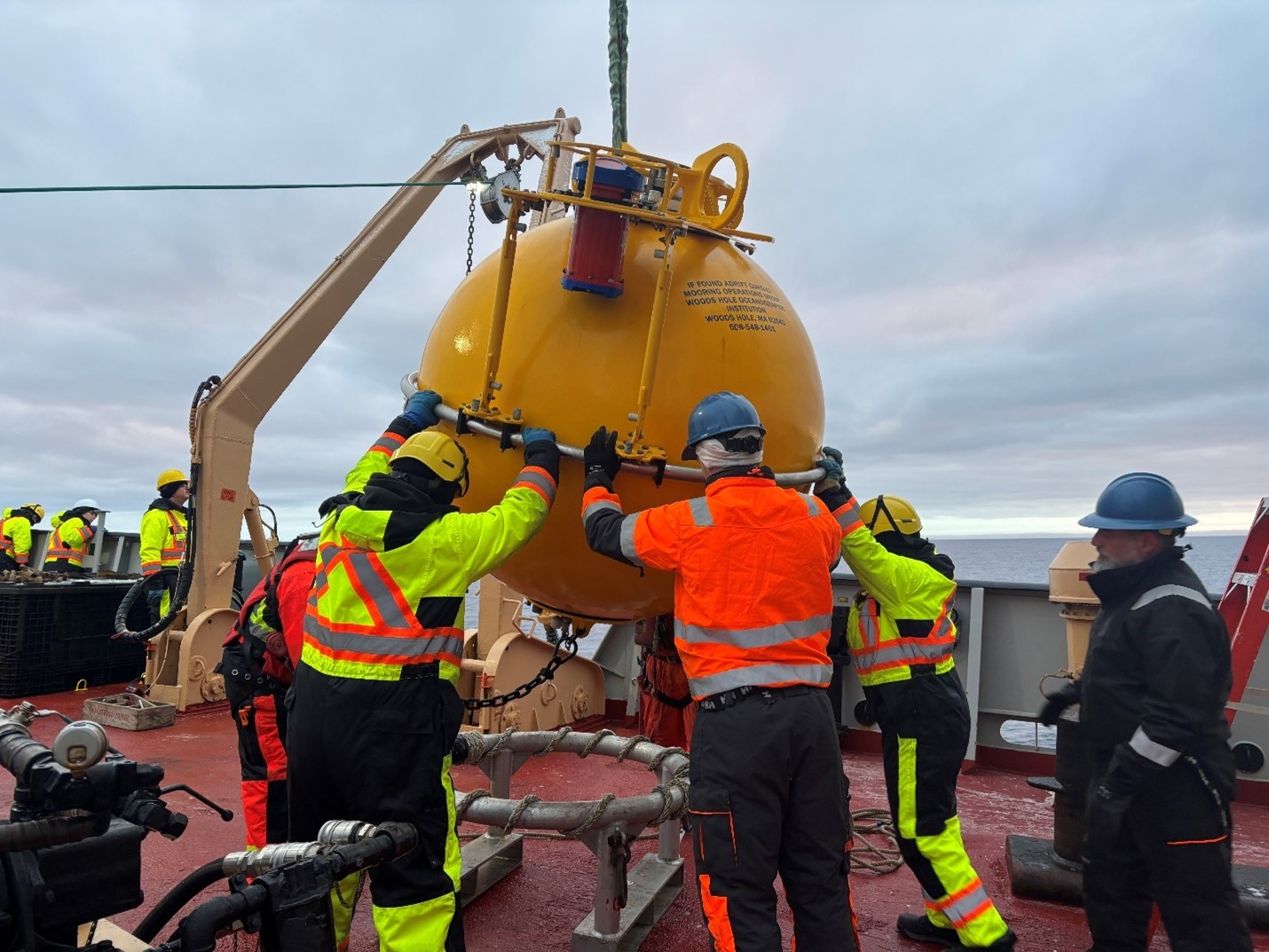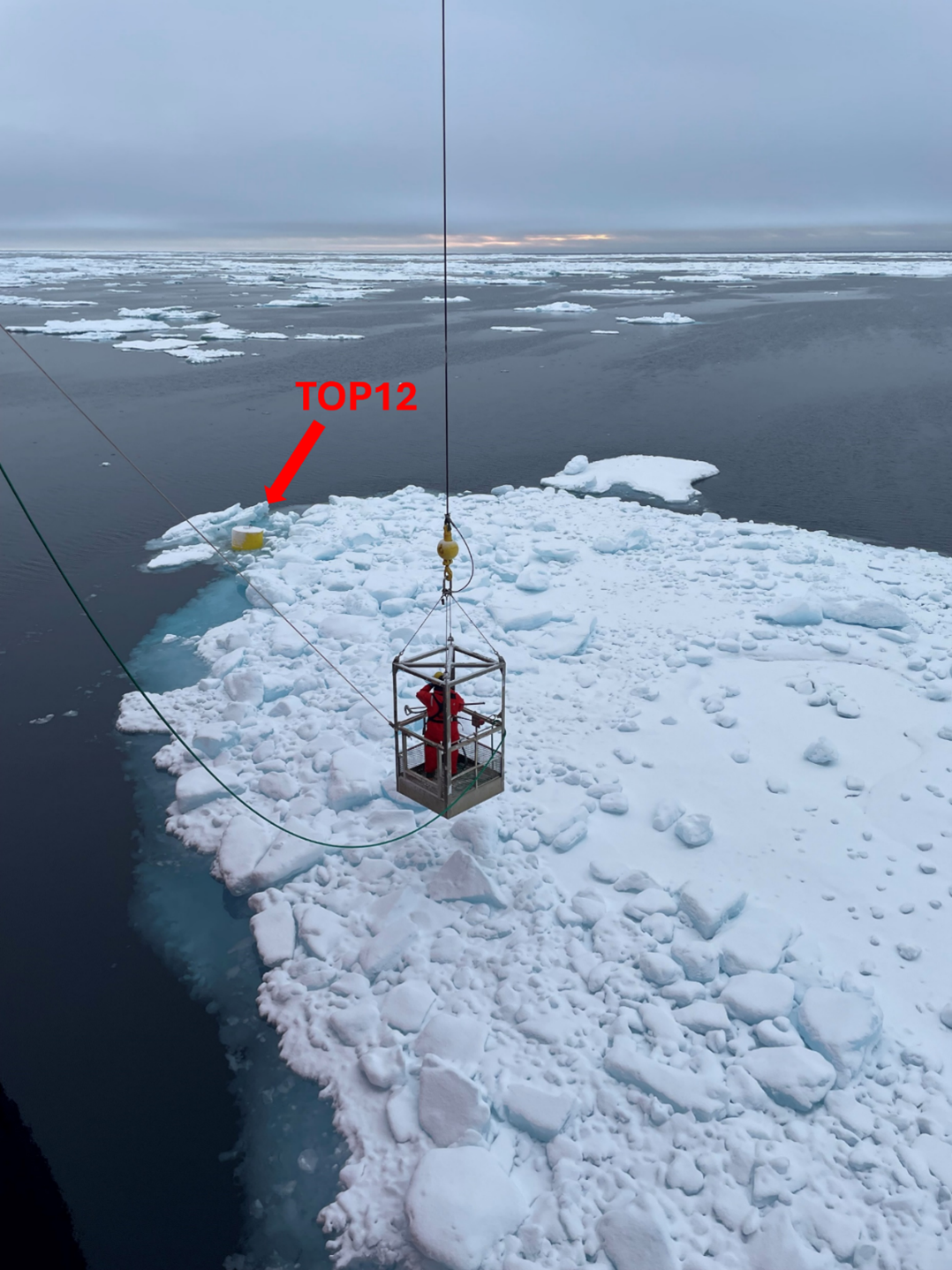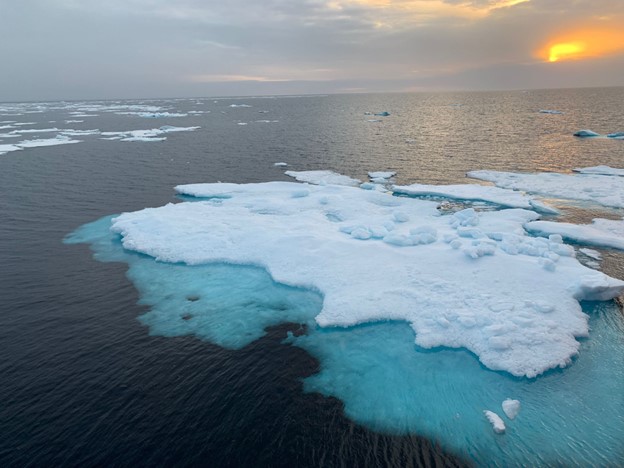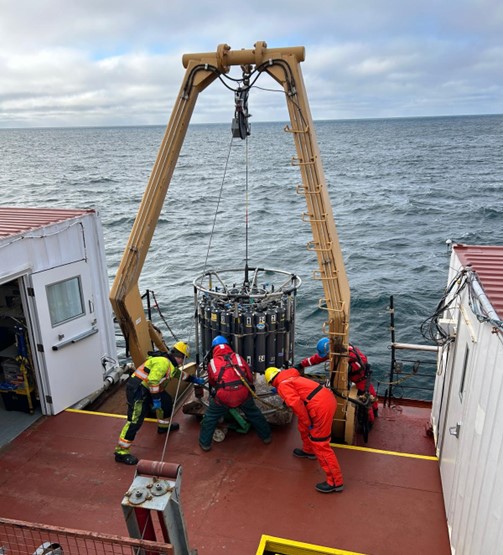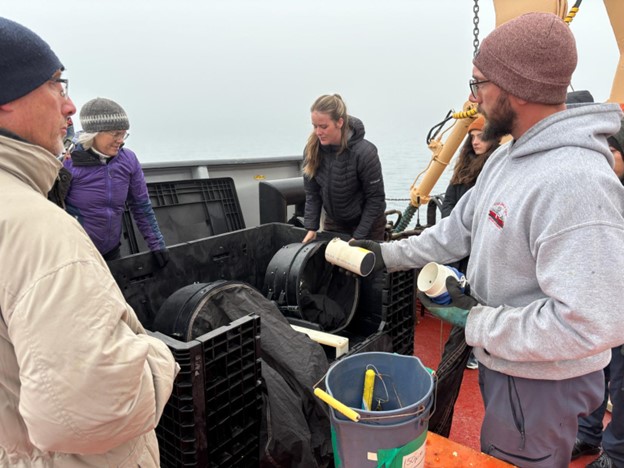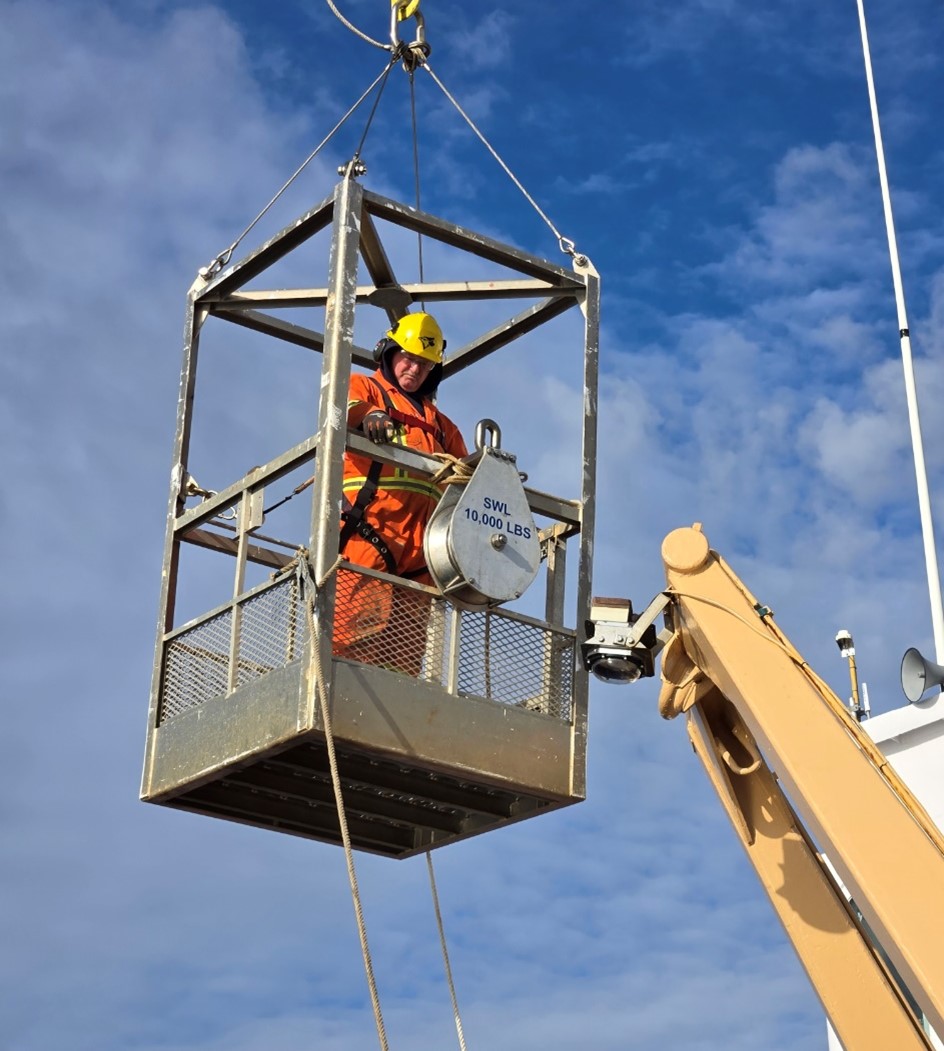2025 Dispatches
Dispatch 34: Last day on the Louis!
Today is our last day on the Louis! We enjoyed a relatively quiet morning, with members of the science team continuing to organize and quality-control sample data, scan cruise documents, and write the cruise report. At 11 am, we met in the boardroom for our final science meeting, during which Jeff O’Brien gave a presentation on the technology behind the tethered ocean profilers (TOPs). We then enjoyed our last lunch on board, which consisted of toasted lumberjack sandwiches, Swedish meatballs, buttered noodles, Thai mixed veggies, and one final amazing salad.
Dispatch 33: Lots to celebrate
Today, we arrived back at Cambridge Bay! We will remain on the Louis until Thursday morning to wrap up any remaining work, which includes processing samples, organizing and quality-controlling data, writing science reports, packing lab equipment/personal gear, and much more. Members of the science team split up to divide and conquer the long list of tasks. For example, Céline Guéguen and Magali Pucet spent the morning processing their last fluorescent dissolved organic matter (FDOM) samples and packing their lab equipment. Meanwhile, Erinn Raftery reviewed the salinity, chlorophyll, ammonium, and dissolved oxygen sample data that were processed on board. The Niskin bottle data and CTD profiles will be organized and published in a few months, after they have been fully calibrated and quality-controlled.
Dispatch 32: Packing and puzzles
Now that we have finished the CTD rosette work on this year’s cruise, the night and day watches are shifting back to normal work schedules. This means that the day watch finally gets to enjoy the incredible breakfasts served on board! Today’s menu included eggs, hashbrown patties, sausage, and French toast with blueberry sauce and whipped cream.
Dispatch 31: Holy smokes!
Today, we continued to steam back towards Amundsen Gulf and Cambridge Bay. During the daily science meeting, Andrew Ross gave a fantastic presentation on his work investigating biotoxins in the Arctic Ocean. Biotoxins are toxic substances produced by harmful algal blooms that can cause illness in humans and marine wildlife. Very few studies have investigated biotoxins in the Arctic Ocean, so Andrew and his collaborator Mackenzie Mueller have been working to establish a time series of biotoxin concentrations in the Canada Basin by collecting samples on the past two BGOS/JOIS expeditions. Today, Andrew shared some of their initial findings, which included identifying weak concentrations of biotoxins known to be harmful to fish, shellfish, and marine mammals on the Beaufort Shelf. Afterwards, we adjourned to the mess and enjoyed an excellent lunch of roasted chicken, vegetarian ravioli, roasted root veggies and potatoes, and green peas.
Dispatch 30: A special experiment for our last CTD cast!
We have officially finished all CTD rosette work on the 2025 BGOS/JOIS expedition! The night watch braved the blistering cold and windy weather to complete our 65th and final rosette cast around 2 am. This cast will not only be remembered as the final cast of this year’s science program, but also as the cast which answered an important scientific question we’ve been pondering – would an egg be able to survive a journey to the bottom of the ocean? Members of the night watch posed this question a few weeks ago, and we’ve been debating ever since. We decided to put it to the test by sending a few eggs down with the rosette on our final cast. Chris Clarke used an old chlorophyll sampling bottle to construct a capsule for the eggs’ journey. He drilled several holes in the bottle to prevent it from being crushed under the weight of the ocean and filled any extra space with foam and paper towels. We then attached the egg capsule to the CTD wire about 150 m above the rosette to avoid sample contamination in the case of an egg explosion. We said goodbye to the eggs, and they began their long, cold journey to the bottom of the Arctic Ocean (3200 m deep!) and back. Around 2 hours later, the egg capsule returned to the ocean surface, and night watch leader Paige Hagel removed it from CTD wire. We were thrilled to discover that all 3 eggs survived their journey – the debate is finally over!
Dispatch 29: Penultimate science station + more northern lights!
We were treated to more incredible views of northern lights around 2:30 this morning! The combination of colorful auroras and fresh pancake ice made this the perfect start to one of our final few days in the Arctic. The night shift spent the rest of the morning running salinity and fluorescent dissolved organic matter (FDOM) samples. Around 10 am, the ice observing team (Kazu Tateyama, Shotaro Muraoka, Takuji Waseda, and Michiharu Shibata) redeployed their electromagnetic sea ice thickness sensor (EM-31), which was brought on board for the last week as we were cruising through open water. Meanwhile, the night shift completed a 3600 m CTD rosette cast at STN-A. This cast was particularly challenging due to the strong winds (25-30 knots), cold temperatures (-19◦C wind chill), and dynamic sea ice conditions. Captain Briggs had to keep adjusting the Louis’ position to dodge large, fast-moving ice floes. Thankfully, the CTD rosette was safely back on board around noon, and the day watch took over for another round of sampling.
Dispatch 28: Infinite lettuce
We are officially 4 weeks into the 2025 BGOS/JOIS expedition – only 1 week left! Remarkably, after many weeks at sea, we are still being served fresh salads every day at lunch. Cook Allison Lodge makes amazing, veggie-filled salads using lettuce that is grown on the Louis! A hydroponic tower (run by logistics officer Nathan Whiffen) is used to produce the lettuce that is served for the final few weeks of each cruise. We are thankful to have this system, as the fresh produce on board is incredibly limited after 4 weeks at sea.
Dispatch 27: The calm before the storm…
We were woken up at 1:30 this morning to more exciting news – northern lights were spotted on the starboard side of the Louis! Most of our expedition route was located too far north to observe auroras, so we were keeping our fingers crossed for clear skies and favorable conditions as we entered the southern-most part of our journey. Luckily, our wishes came true, and we were treated to some unforgettable views of this incredible natural phenomenon.
Dispatch 26: Finishing the BL-Line
We survived! After an incredibly busy night, the night watch wrapped up the shallow cast (80 m) at BL-1 around noon today, officially marking the end of the BL-line. Over the course of 24 hours, we completed 6 CTD rosette casts, 2 CTD-only casts, and 12 plankton sampling nets. We additionally collected 1120 water samples, many of which will be analyzed on board over the next few days. Safe to say, the BL-line is not for the weak! Huge thanks to deck crew for helping to complete all these casts!
Dispatch 25: The BL-Line
Happy Canadian Thanksgiving! We are incredibly grateful to have spent 4 productive, science-filled weeks in the Arctic! We celebrated today with 3 festive meals prepared by our amazing cooks. Our breakfast featured a Thanksgiving casserole (in addition to the normal eggs, bacon, and hashbrowns). At lunch, we were treated to a massive feast of roasted turkey, gravy, boiled potatoes, veggie quiche, and raisin molasses pudding. Finally, our supper consisted of pulled pork/tofu sandwiches, poutine (a Canadian classic!), and mac and cheese.
Dispatch 24: Shrinky cups
We started the day by recovering TOP14, a tethered ocean profiler that was deployed around 79◦N, 145◦W last year on the 2024 BGOS/JOIS expedition. The recovery process was wrapped up by 11 am, and we began the short steam over to CB-3. After a quick lunch of Catalina cranberry chicken, Big Mac wraps, sweet potato fries, and garlic mixed veggies, the day watch prepped the CTD rosette for another 3800 m cast. This cast was extra exciting because we finally sent the decorated styrofoam “shrinky” cups (along with the CTD rosette) to the bottom of the Arctic Ocean!
Dispatch 23: A spontaneous science station!
The night shift completed a 3600 m CTD rosette cast at CB-17 early this morning. The cold weather made this cast extra challenging, as the wire block and chummy kept freezing. Sampling was completed by 9 am, and the night watch went to enjoy a highly anticipated late breakfast/lunch of eggs, diced hashbrowns, and banana pancakes with chocolate syrup.
Dispatch 22: Finishing the PP-Line
Early this morning, the night watch completed a 3000 m CTD rosette cast at PP-6 followed by a 2400 m cast at PP-5. This officially concludes our work on the PP-Line! The PP-Line extends eastward up the continental slope, approaching its namesake of Prince Patrick Island. The full line was originally completed during the 2007 BGOS/JOIS expedition. However, most years we are only able to complete stations at PP-7 and PP-6 due to time constraints. In fact, PP-5 has not been completed since 2008! Luckily, the longer duration of this year’s cruise afforded us the opportunity to visit PP-5 and complete another CTD rosette cast. Co-chief scientist Sarah Zimmermann spent the afternoon comparing the profile data collected at PP-6 and PP-5 to data collected at nearby stations. We were excited to observe gradients in key water mass properties, including temperature and oxygen, as we transition from the deep Canada Basin to the boundary (near PP-5).
Dispatch 21: Our last ice station
Time flies! We are officially 3 weeks into the 2025 BGOS/JOIS expedition and have only another 2 to go! The night watch wrapped up a 3500 m CTD rosette cast at PP-7 around 7 am, before going to enjoy a breakfast of eggs, turkey bacon, and strawberry cheesecake French toast bake. We spent the remainder of the morning hunting for another good ice floe, hoping to complete our third ice station today as the winds are projected to increase later this week.
Dispatch 20: More polar bears + an ice station!
The day watch woke up this morning to exciting news – a mother polar bear and her cub were spotted wandering near the Louis! We ran out on deck, many of us still in our pajamas, thrilled at the opportunity to see some more bears. The pair seemed very curious about the Louis, roaming around and looking up at everyone on board. After about 20 minutes of bear watching, we continued on our way in search of an ice floe (far away from the bears!) for our planned ice station.
Dispatch 19: Headed back southeast
Early this morning, the night watch completed a 3750 m CTD rosette cast at CB-16. We then continued our search for a large, multi-year ice floe in the areas near CB-13 and CB-15. We were once again disappointed to discover that most of the floes in this region consist primarily of thin, first-year ice, which is unsuitable for our planned ice station. We pivoted from our plans to complete the ice station today and, instead, decided to wrap up the last few science stations in this area.
Dispatch 18: On the hunt for old ice…
We have officially reached the half-way point of the 2025 BGOS/JOIS expedition! Today, we continued our search for an ice floe that is sufficiently large and thick for us to complete a full ice survey and deploy additional buoys. Unfortunately, the ice floes in this region appear to be predominantly a patchwork of thick multi-year ice (> 1 m) and thin first year ice (20-30 cm). We are searching for an ice floe with a more uniform thickness, which will provide a safer base for our ice work. We plan to continue our search in the eastern part of the Canada Basin, where there is a higher concentration of old ice.
Dispatch 16: Mooring B Deployed and a Polar Bear Sighting!
And that’s a wrap on the mooring operations for the 2025 BGOS/JOIS expedition! This morning, we redeployed Mooring B. The deployment process went smoothly, thanks to the help of our amazing deck crew. However, we had some unexpected excitement about half-way through the deployment when a polar bear was spotted approaching the Louis! Everyone came out to the fore deck to snap pictures and watch our new polar bear friend wander around the ice floes. Meanwhile, the deployment process continued with roughly 3800 m of wire and numerous instruments being lowered into the ocean. The polar bear ended up remaining nearby for the duration of Mooring B’s deployment, which we finished around 3 pm. Afterwards, we were happy to escape from the cold to celebrate our third and final mooring deployment. Huge thanks to the crew for helping make this year’s mooring work such a success!
Dispatch 15: Mooring B and TOP13 Recovered
Today was a busy day for the BGOS team (Jeff O’Brien, Tim McDonough, Jim Ryder, Cory Beatty, Jennifer Kosty)! We started with recovering Mooring B in the morning/early afternoon. The relatively thick sea ice pack made Mooring B’s recovery slightly more challenging. After we identified Mooring B’s precise location, the ship spent around 30 minutes breaking a large hole in the ice pack for the recovery operation. At 11:30 am, Mooring B was released from its anchor, and we were delighted to see its top sphere pop up right within the hole we had created. We then began the long process of winching Mooring B’s instruments and nearly 3800 m of wire on board. Although we faced a wind chill of -20◦C, we were treated to some beautiful views of the sea ice as the sun finally emerged from behind the clouds. Mooring B’s bottom pressure recorder and acoustic releases were on deck by 3:15 pm, marking the end of the recovery process. After 4+ hours in the blistering cold, we were excited to warm up with a well-deserved supper. Tonight was pizza night on the Louis, much to the excitement of the science team!
Dispatch 14: Two weeks on the Louis!
It’s officially been two weeks since we boarded the Louis in Cambridge Bay! In that time, we’ve traveled nearly 2200 miles, recovered and redeployed two moorings, recovered three buoys, and completed 25 CTD rosette casts. We still have another three weeks on board and are excited for the science work to continue!
Dispatch 13: The RS Line
We survived the RS line! The day started around 3:45 am when we arrived at RS-6, the first of the 5 RS line-science stations. Upon arrival, the night watch spent nearly 3 hours completing a 3800 m CTD rosette cast. After the rosette was safely back on deck, the night watch began sampling, while the ship steamed towards our next station (RS-4). The RS line is located on the continental slope of the Northwind Ridge, so the stations are spaced close together and get progressively shallower. We arrived at RS-4 around 9 am, where the night watch wrapped up their shift with another 2200 m cast.
Dispatch 12: Mooring A Deployed
A quick turnaround! This morning, we successfully redeployed Mooring A, a mere 19 hours after it was brought on board yesterday. The weather conditions were a bit harsh, with 1-2 meter swells, wind chills around -12◦C, and occasional flurries. However, after many conversations between Captain Briggs, co-chief scientist Paul Macoun, and the BGOS team, it was ultimately decided that we could safely go ahead with Mooring A’s deployment.
Dispatch 11: Mooring A Recovered
Today, we recovered Mooring A! The day started with the BGOS team (Jeff O’Brien, Tim McDonough, Jim Ryder, Cory Beatty, Jennifer Kosty) meeting at 6:45 am to identify Mooring A’s precise position. This process involved traveling to 3 locations, each approximately 1.5 km away from Mooring A’s drop location, where we sent an acoustic ping to its bottom releases. We used the signal’s travel time to determine Mooring A’s exact location, which was 37 m from where it was dropped last year.
Dispatch 10: Change of Plans, TOP15 Recovered
Change of plans! During the daily science meeting, co-chief scientist Paul Macoun informed us that there has been a last-minute adjustment in the schedule for the next few days. Ice specialist Kyle McDougall warned that next Wednesday the forecast at the site of Mooring A included stormy weather and rough seas, resulting from the pressure gradient between two nearby systems. Rough weather can be common during this time of the year, so Paul and the BGOS team decided that we should take advantage of the relatively calm seas forecast for the next couple of days and immediately head towards Mooring A. The plan is now to recover Mooring A tomorrow and redeploy on Tuesday. We will then decide if we want to return to CB-17 and the originally planned schedule, or if it will be more advantageous for us to work our way backwards through the stations up north.
Dispatch 9: Back in the ice
Today, we woke up back in the ice! We arrived at CB-51 around 10 am, and the night watch kicked off the station by collecting zooplankton samples off the fore deck. The samples collected here were the largest taken on the cruise so far, so we briefly paused the 11 am science meeting so that Marguerite Larriere could show us the specimens. We were excited to see a diverse collection of zooplankton, ranging in size from a few millimeters to centimeters, including at least one ctenaphore (or comb jelly). These creatures are iridescent, bioluminescent jellies that propel themselves forward using short hair-like structures, called cilia. The increased volume of the zooplankton collected here at CB-51 may be due to our location near the ice edge, which can be a more productive region.
Dispatch 8: Mooring D Deployed
The night watch wrapped up a nearly 3700 m CTD rosette cast at CB-19 around 2 am this morning. We then steamed back to Mooring D’s drop location and began the deployment process at first light (around 8 am). 6 hours later, Mooring D was successfully deployed!
Dispatch 7: Mooring D Recovered
This morning, we recovered Mooring D, the first of the three BGOS moorings! The recovery process started at 6:30 am, with the BGOS team (Jeff O’Brien, Tim McDonough, Jim Ryder, Cory Beatty, and Jennifer Kosty) working with the bridge to identify Mooring D’s exact location. After a quick breakfast of eggs, hashbrowns, and blueberry pancakes (which were a big hit amongst the science team), we headed to the fore deck, and Jeff O’Brien sent the signal to release Mooring D from its anchor. Luckily, we were in calm, ice-free water so it was easy to spot Mooring D’s bright yellow top sphere when it surfaced a few minutes later. Deckhand Jerome Sibley once again entered the man-basket and clipped the sphere into the winch. We then began the 3-hour long process of bringing Mooring D and its numerous instruments back on board. The recovery process went smoothly, thanks to the help of boatswain Rico Amamio and the many deckhands and cadets who were there to assist!
Dispatch 6: Recovery of TOP12 and ITP142
Today, we recovered two ocean profilers (TOP12 and ITP142) that were deployed last year on the 2024 BGOS/JOIS expedition. TOP12, a tethered ocean profiler, was recovered around 8:30 this morning, while ITP142, an ice tethered profiler, was recovered just after noon. Both systems include (1) a surface instrument package which sits atop an ice floe or floats in the water, and (2) an instrumented profiler that climbs up and down an attached wire, returning depth profiles of temperature and salinity as the system drifts. The surface package transmits the profiler data and the system’s position to the WHOI servers via satellite, allowing us to track the profilers after they’ve been deployed. TOP12 and ITP142 happened to be drifting near our planned cruise track, so we were excited at the opportunity to recover them since the systems were running low on battery.
Dispatch 5: Flurries and Sea Ice!
We woke up this morning to snow flurries and sea ice! Now that we are entering areas with higher sea ice concentration, the ice observing team from Japan (Kazu Tateyama, Shotaro Muraoka, Takuji Waseda, and Michiharu Shibata) spent the morning setting up their electromagnetic sensor (EM-31) which will continuously measure sea ice thickness along the cruise track. The EM-31 system will be mounted near the bow of the ship, approximately 5 m above the sea surface, where it will measure sea ice thickness before the ship breaks apart the ice.
Dispatch 4: A successful first station!
Happy fall equinox! Today marks the start of a 6-month period during which the sun will never rise above the horizon at the north pole. We had an auspicious start to autumn, as the first science station of the 2025 expedition was a success! We completed two casts at AG-5, one designated for the collection of DNA/RNA samples and one regular geochemical cast. The night watch (Paige Hagel, Marguerite Larriere, Collette LeClerc, Magali Pucet) led the DNA/RNA cast at 10 am. We then broke for a quick lunch of trout, quesadillas, tater tots, and roasted veggies. After lunch, both watches helped collect samples of phytoplankton and zooplankton on the fore deck, by lowering sampling nets down to a depth of 20 m and 100 m, respectively. The day watch (Chris Clarke, Celine Gueguen, Jennifer Kosty, Annabel Payne, Andrew Ross) then took over for the geochemical cast at 1 pm.
Dispatch 3: More Science Prep
We are currently steaming towards AG-5 at a speed of approximately 10 knots. Last night, members of the science team set up the TSG (thermosalinograph), which collects measurements of temperature, salinity, chlorophyll, fluorescence CDOM (colored dissolved organic matter), and pCO2. Water is pumped from the hull to the main lab, where these properties are measured every 15 seconds, providing a high-resolution record for the entire cruise track.
Dispatch 2: Prepping for Science Operations
We remained in Cambridge Bay through the late afternoon a fter yesterday’s refueling. In the morning, the team from WHOI worked with the ship’s crew to prepare the fore deck for upcoming mooring and buoy work. Other members of the science team spent the morning testing lab equipment and planning for the start of science operations. The science plan is designed to be flexible, as we must consider the current and future sea ice and weather conditions. For example, we are currently monitoring a low-pressure system which has moved into the central Beaufort Sea over the past few days.
Dispatch 1: First Day on the Louis!
All aboard! Today is our first full day on the CCGS Louis S. St-Laurent, and the beginning of the 2025 BGOS/JOIS expedition. The science team arrived at the Cambridge Bay airport yesterday afternoon and were transported to the Louis via helicopter. The journey to Cambridge Bay is a long one, typically involving multiple days of travel and several airports! Once on board, the science team got busy unpacking (science equipment, personal items, clothes, etc.) and organizing lab spaces. After a long day of traveling and work, we were treated to our first meal on the Louis – chicken strips, pork chops, veggie burgers, and fries!
